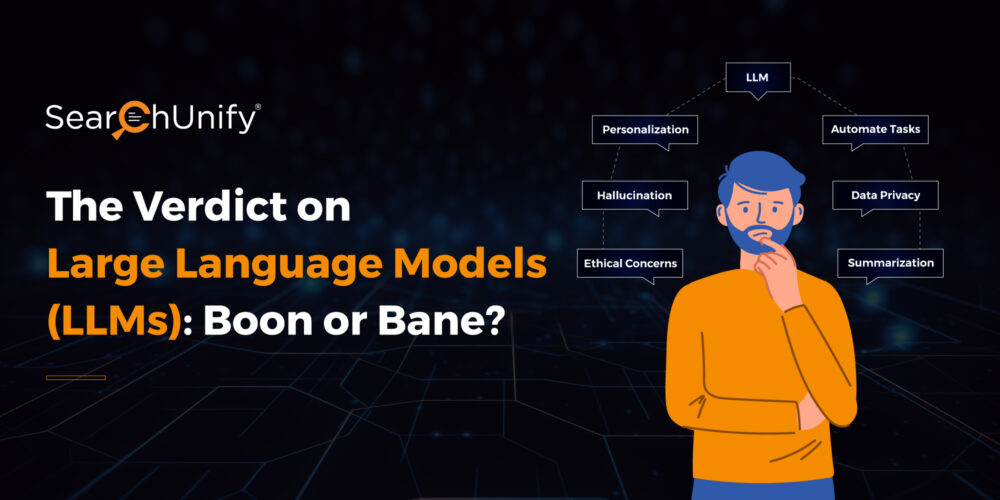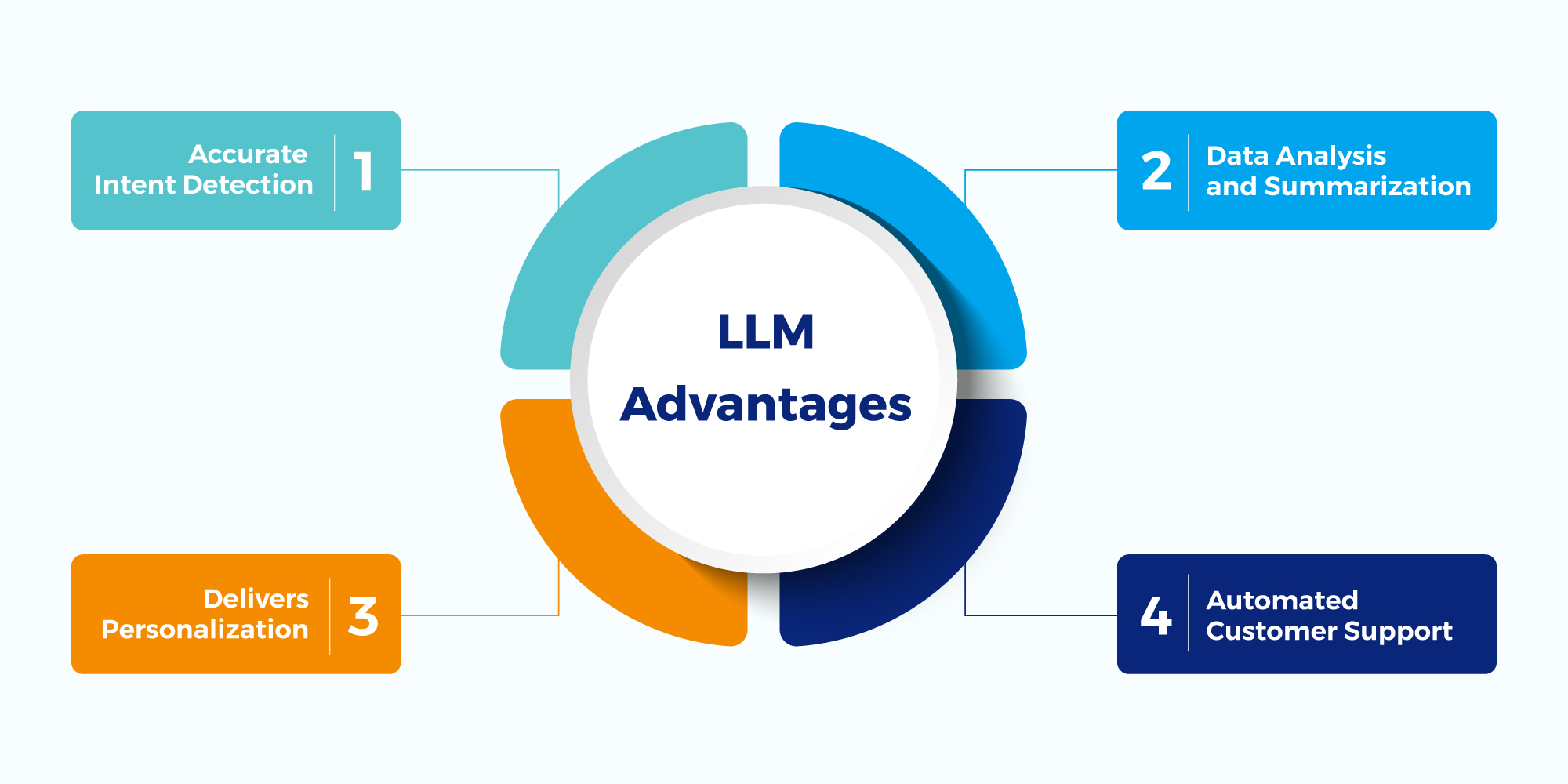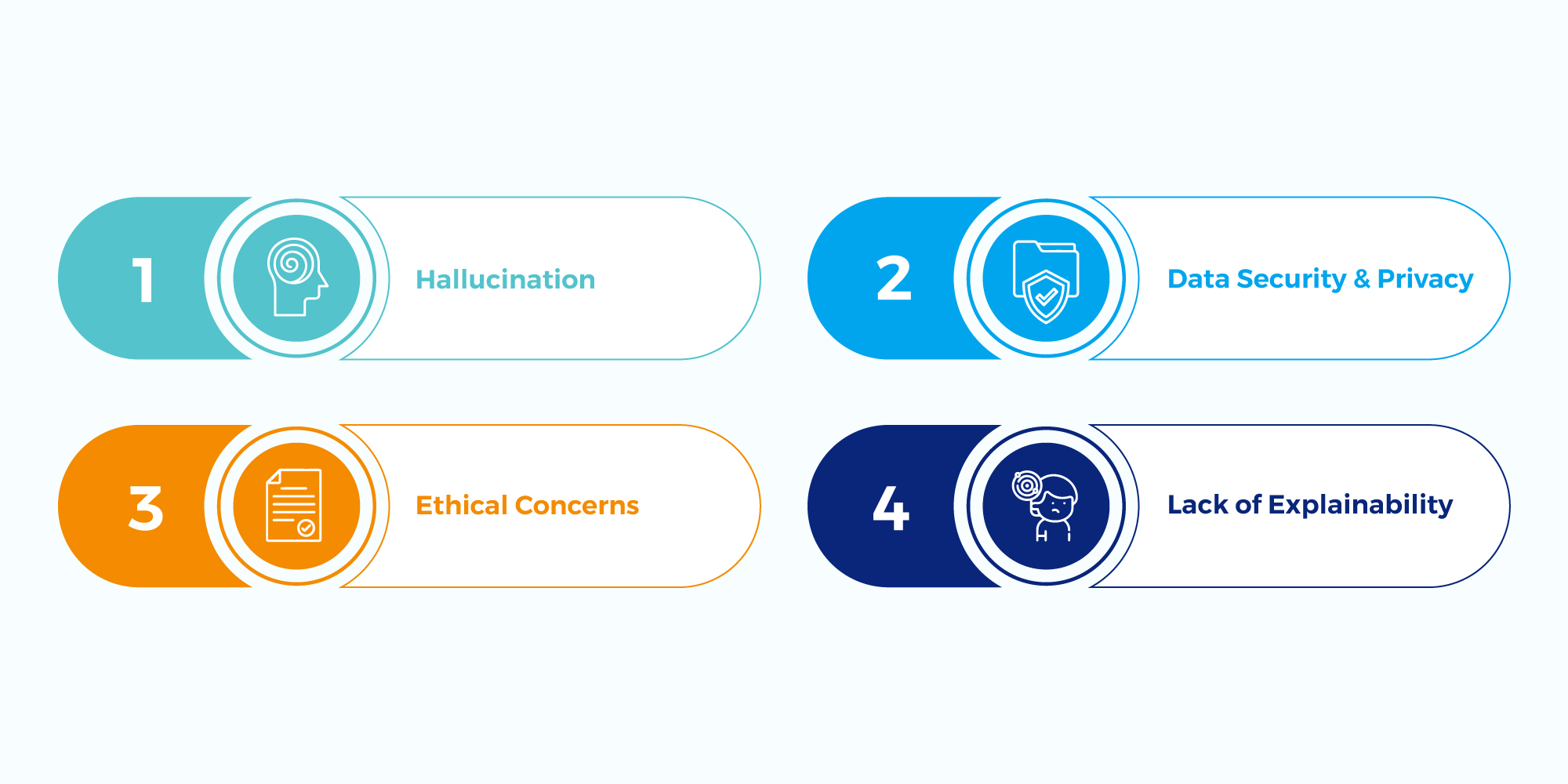
A salesforce survey stated that 68% of employees reported that GenAI will help them better serve their customers and revolutionize the customer experience.
In the past, the idea of machines comprehending language and crafting human-like text responses seemed like a distant dream.
But in today’s ever-evolving landscape of artificial intelligence (AI), large language models (LLMs) are turning that dream into reality. Thanks to their sophisticated algorithms, LLMs sift through vast datasets, generating content that mimics human language and boosting efficiency at an unprecedented pace.
Yet, amidst the groundbreaking capabilities of LLMs, we must acknowledge rising challenges like hallucination and data privacy that cast a shadow over the promises of this cutting-edge technology.
As we delve into this blog post, we aim to explore the dual facets of this technology. So, without further ado, let’s discover whether LLMs are a boon or bane!
Exploring LLMs Benefits: Navigating Infinite Possibilities into a New Era of Innovation
Like every story has two sides, LLMs have positive and negative aspects too. Let’s start with the bright side first.

1. Accurate Intent Detection
LLMs, equipped with advanced natural language processing, excel in tasks such as text generation, language translation, and crafting creative content.
They have proven beneficial for customer support along with other industries. Moreover, they comprehend the intent of user queries and generate personalized responses quickly, which enhances the customer experience.
[Also Read: Maximizing NLP Capabilities with Large Language Models]
2. Data Analysis and Summarization
LLMs can zip through vast datasets faster than ever, providing summarized information. They also transform scattered data into meaningful insights, offering a competitive edge to various industries like finance, customer support, and many more. Especially in places where they need to crunch heaps of data pronto for accurate results.
Picture this: a support agent gets a tricky ticket with all sorts of scattered info. Boom! Enter LLM-powered solutions steps into address these challenges head-on. This powerhouse tech can extract valuable information from unstructured data, helping organizations make sense of large datasets. Support agents can search for the relevant query.
LLMs, equipped with enterprise knowledge, can analyze their data, deliver relevant results, and expedite ticket resolution. Well, this can be one of LLMs use cases for enhancing efficiency.
3. Delivers Personalization
The significant advancement in LLMs led to the generation of personalized responses by analyzing user behavior, preferences, and feedback. It enables companies to tailor content, recommendations, and services to individual users, enhancing customer satisfaction and engagement.
Did you know 59% of customers say personalized engagement based on past interactions is paramount to winning their business?
4. Automated Customer Support
LLMs-powered chatbots and virtual assistants handle customer queries quickly and provide pertinent information. Additionally, they can analyze ticket details and generate concise titles or summaries, fill content gaps, and aid in the quick resolution of tickets. This not only enhances customer support but also reduces the workload on human agents, allowing them to focus on more complex issues.
Addressing the Hurdles: Navigating Challenges Encountered by LLMs
As we’ve already explored the bright side, it’s not all smooth sailing for LLMs. These models face challenges that make companies hesitant to embrace LLMs fully.
Let’s explore these challenges in detail:

1. Hallucination
Within the realm of exceptional capabilities, hallucination emerges as one of the serious concerns with LLMs. LLMs hallucination refers to generating content that appears accurate and contextually relevant but can lack a factual basis. It elevates the risk of spreading misinformation, exposing confidential information, and creating unrealistic expectations.
But that’s not all. Training data can be intentionally manipulated with false or biased information. And detecting such manipulation is extremely difficult in massive datasets. As a result, LLms can generate wrong, unfair, or discriminatory outcomes, impact decision-making, and potentially harm the organization’s reputation.
Suppose a customer contacts a virtual assistant about an ongoing “buy one, get one free” promotion. The virtual assistant, relying on outdated data, mistakenly asserts that the promotion is still active. Consequently, the customer might make a purchase expecting the free item, only to discover later that the promotion has ended, leading to dissatisfaction and potential customer trust issues.
In such scenarios, inaccurate responses contribute to bad customer experience, damaging the organization’s reputation.
Fine-tuning can help mitigate LLM hallucinations to a certain extent but some frameworks help in overcoming this. Additionally, it is a costly and time-consuming LLM training process.
2. Data Security & Privacy
LLMs often train on extensive datasets to learn patterns and relationships within the data. There are chances that training data may contain sensitive information. It can potentially expose confidential data to others if proper security measures are not in place, raising data security and privacy concerns.
Imagine the following scenario where you’ve just input sensitive product feature details into an LLM to get some quick assistance. The LLM helped you out, but here’s the catch: depending on how it’s configured, that confidential information might linger within the LLM and be accessible to other users, maybe your competitors.
The alarming fact about LLMs is that there is no deleting an option, which poses data leakage and misuse risks and imposes legal implications.
71% expressed concern that GenAI will introduce new security threats to their data.
3. Ethical Concerns
One of the significant concerns with LLMs is their potential misuse, which raises ethical questions, especially in areas where decisions impact an organization’s reputation. The pattern recognition power in LLMs can turn unstructured data into valuable information, but sometimes this info can be sensitive. This opens the door for disseminating misinformation or propaganda, generating bogus evaluations and comments.
Looking ahead, if you’re planning to integrate LLMs with your business operation, select LLMs that adhere to ethical guidelines and also develop policies to oversee their usage.
While more than 40% of companies have adopted AI-powered services, only 6% have established clear guidelines for the ethical and responsible use of AI.
4. Lack of Explainability
LLMs are working as a “Black box model,” which means the inner workings of complex LLMs can be opaque and lack transparency. They can provide explanations as per user input but can give false positive answers with full confidence. These models don’t have inherent knowledge but rather generate responses based on patterns learned from diverse data sources during training. Therefore you can’t 100% trust LLMs’ responses without double-checking them with other reliable sources.
Inexplicability raises questions about the trusting LLMs’ output. And this becomes problematic for various industries, where decisions based on LLM outputs could impact the customer experience, leading to financial and reputational losses for the organization.
Embracing the Tide: Ready to Navigate the Inevitable Onslaught of LLMs
As we’ve uncovered both sides of large language models , you’ve to decide whether LLMs are the champions or villains. They can be powerful tech for good, empowering us to navigate the information deluge and unlock new possibilities. But it’s up to us, the users, the developers, and the policymakers, to ensure they are developed ethically and used responsibly.
Be proactive in the face of constant change by leveraging the power of LLMs. Worried about data and privacy risks associated with LLMs?
Fret not! Explore our next blog post, where we will address the LLMs data security and privacy concerns.



















